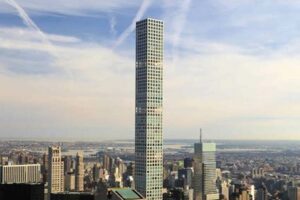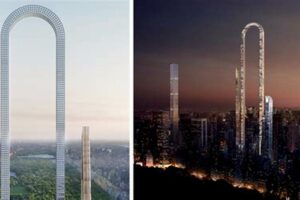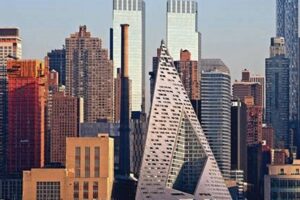A New York City skinny skyscraper, also known as a “slender tower” is a modern high-rise building characterized by its narrow width and great height. These buildings often have a width-to-height ratio of less than 1:10, giving them a remarkably slender appearance when viewed from the street.
New York City skinny skyscrapers have gained popularity in recent years due to several factors. First, they allow developers to maximize the use of valuable land in dense urban areas like Manhattan. Second, their sleek and striking designs can serve as landmarks and architectural icons. Third, they offer residents and tenants unique and luxurious living and working spaces with panoramic views of the city.
Some notable examples of New York City skinny skyscrapers include 432 Park Avenue, 111 West 57th Street, and the Steinway Tower. These buildings have redefined the city’s skyline and set new standards for sustainable and innovative design.
1. Height
The exceptional height of New York City skinny skyscrapers is a defining characteristic that sets them apart from other types of buildings. This verticality is crucial to their identity and offers several advantages:
- Land optimization: By building upwards, skinny skyscrapers maximize the use of valuable land in dense urban areas like Manhattan, where land is scarce and expensive.
- Iconic status: Their soaring heights make skinny skyscrapers landmarks and architectural icons, contributing to the city’s distinctive skyline.
- Panoramic views: Residents and tenants enjoy breathtaking, panoramic views of the city from the building’s upper floors, a highly sought-after amenity in New York City.
- Investment potential: Tall buildings can attract investors and buyers seeking prestigious addresses and exclusive living experiences.
The height of New York City skinny skyscrapers also presents engineering and design challenges. Architects and engineers must carefully consider wind resistance, structural stability, and efficient elevator systems to ensure the safety and functionality of these towering structures.
Overall, the height of New York City skinny skyscrapers is a key factor in their design, appeal, and impact on the city’s skyline. These exceptionally tall buildings represent a unique blend of architectural innovation, urban planning, and real estate development, shaping the future of urban living in New York City.
2. Slenderness
The slenderness of New York City skinny skyscrapers is a defining characteristic that sets them apart from other types of buildings. This narrowness is achieved through a width-to-height ratio of less than 1:10, resulting in a remarkably narrow appearance when viewed from the street.
The slenderness of skinny skyscrapers offers several advantages:
- Reduced wind resistance: The narrow profile of skinny skyscrapers reduces wind resistance, making them more stable and efficient in high-wind conditions.
- Enhanced structural integrity: The slender design allows for a more rigid and stable structure, reducing the risk of swaying and collapse.
- Maximized natural light: The narrow width allows for more windows on each floor, maximizing natural light and reducing the need for artificial lighting.
- Distinctive aesthetic: The slenderness of skinny skyscrapers gives them a unique and striking appearance, contributing to the city’s distinctive skyline.
However, the slenderness of skinny skyscrapers also presents challenges:
- Engineering complexity: Designing and constructing slender skyscrapers requires advanced engineering techniques to ensure structural stability and safety.
- Limited floor space: The narrow width of skinny skyscrapers limits the amount of floor space available, which can affect building functionality and tenant capacity.
- Higher construction costs: The complexity of constructing slender skyscrapers often leads to higher construction costs compared to more conventional buildings.
Despite these challenges, the slenderness of New York City skinny skyscrapers remains a key defining characteristic that contributes to their architectural appeal, structural efficiency, and iconic status.
3. Views
The breathtaking views offered by New York City skinny skyscrapers are a major attraction for residents and tenants. The buildings’ exceptional height and slenderness allow for expansive windows that provide unobstructed views of the city’s iconic landmarks, bustling streets, and waterfront vistas.
The panoramic views from skinny skyscrapers are not merely an amenity but an integral part of the living experience. They offer a sense of connection to the city, allowing residents to witness the changing seasons, the vibrant energy of urban life, and the ever-evolving skyline. These views also provide a sanctuary from the hustle and bustle of the city, creating a serene and inspiring environment within the confines of the building.
The importance of views in New York City skinny skyscrapers is reflected in their design and marketing. Developers often prioritize floor-to-ceiling windows and balconies to maximize the visual impact of the views. Real estate listings for skinny skyscraper apartments frequently highlight the panoramic vistas as a key selling point.
Beyond their aesthetic appeal, the views from skinny skyscrapers also have practical benefits. Natural light floods the interiors, reducing the need for artificial lighting and creating a more comfortable and energy-efficient living environment. The views can also improve mental well-being by providing a connection to the outdoors and reducing feelings of isolation.
In conclusion, the panoramic views offered by New York City skinny skyscrapers are not simply a luxury but an essential component of the living experience. They enhance the quality of life for residents, contribute to the building’s architectural appeal, and reflect the city’s vibrant and ever-changing nature.
4. Luxury
The connection between luxury and New York City skinny skyscrapers is deeply intertwined. Skinny skyscrapers are designed to cater to affluent buyers and renters who seek the highest levels of comfort, convenience, and exclusivity. These buildings offer a range of high-end amenities and finishes that enhance the living experience and elevate the status of the
residents.
Some of the luxury amenities commonly found in New York City skinny skyscrapers include:
- 24-hour doorman and concierge services
- State-of-the-art fitness centers
- Rooftop terraces with panoramic views
- Private dining rooms and wine cellars
- Screening rooms and entertainment lounges
In addition to these amenities, skinny skyscrapers often feature luxurious finishes and materials throughout their interiors. This includes:
- Floor-to-ceiling windows with stunning views
- Hardwood floors and imported stone
- Custom kitchens with high-end appliances
- Spa-like bathrooms with marble and glass
The combination of high-end amenities and luxurious finishes creates an exclusive and sophisticated living environment that appeals to discerning buyers and renters. Skinny skyscrapers have become synonymous with luxury living in New York City, offering a level of comfort and convenience that is unmatched by other types of buildings.
The presence of luxury in New York City skinny skyscrapers is not merely a marketing ploy but a reflection of the changing demographics and lifestyles of the city’s residents. As New York City has become increasingly global and affluent, the demand for luxury housing has grown. Skinny skyscrapers cater to this demand by providing a unique and exclusive living experience that meets the needs and aspirations of the city’s most discerning residents.
5. Sustainability
The pursuit of sustainability has become increasingly important in the design and construction of New York City skinny skyscrapers. As the city strives to reduce its carbon footprint and promote environmental responsibility, developers are incorporating various sustainable elements into these towering structures.
- Energy Efficiency: Many skinny skyscrapers employ energy-efficient systems to reduce their environmental impact. This includes using LED lighting, motion sensors to control lighting and HVAC systems, and installing double-glazed windows to minimize heat loss. By implementing these measures, buildings can significantly reduce their energy consumption and contribute to the city’s sustainability goals.
- Green Roofs: Green roofs are another common sustainable feature in New York City skinny skyscrapers. These roofs are partially or fully covered with vegetation, providing numerous environmental benefits. Green roofs help reduce the urban heat island effect by absorbing solar radiation and releasing moisture through evapotranspiration. They also improve air quality by filtering pollutants and producing oxygen. Additionally, green roofs can provide habitats for wildlife and enhance the aesthetic appeal of the building.
- Water Conservation: Water conservation is another important aspect of sustainability in skinny skyscrapers. Low-flow plumbing fixtures, rainwater harvesting systems, and drought-tolerant landscaping are some of the measures employed to reduce water consumption. By conserving water, these buildings can help mitigate the strain on the city’s water resources and promote responsible water use.
- Sustainable Materials: The use of sustainable and recycled materials is becoming more prevalent in the construction of skinny skyscrapers. This includes incorporating recycled steel, wood from sustainably managed forests, and low-VOC (volatile organic compound) materials to minimize the environmental impact of the building’s materials.
The incorporation of sustainable design elements in New York City skinny skyscrapers is a testament to the growing awareness of environmental responsibility in the real estate industry. As the city continues to grow and evolve, these sustainable features will play a crucial role in reducing the environmental impact of these iconic structures and contributing to a more sustainable urban environment.
6. Land use
In the densely populated urban environment of New York City, land is a precious commodity. New York City skinny skyscrapers play a crucial role in optimizing land use, allowing for efficient and sustainable development in a vertical direction.
- Maximizing Vertical Space: Unlike traditional buildings that spread horizontally, skinny skyscrapers ascend vertically, maximizing the use of airspace. This allows developers to create more residential, commercial, and office space within a limited footprint, reducing the need for urban sprawl and preserving valuable land for other purposes.
- Efficient Land Utilization: The slender design of skinny skyscrapers makes them particularly suitable for narrow or irregularly shaped plots of land that would be challenging to develop with conventional buildings. By fitting into smaller spaces, skinny skyscrapers enable efficient land utilization and contribute to the vibrant urban fabric of New York City.
- Increased Density: Skinny skyscrapers facilitate increased population density within a given area. By accommodating more people in a vertical space, they help reduce urban sprawl and promote sustainable living practices. The increased density also supports the development of vibrant and walkable neighborhoods, fostering a sense of community.
- Economic Benefits: The efficient use of land through skinny skyscrapers has significant economic benefits. By maximizing the development potential of a site, developers can create more housing units, office spaces, and retail stores, contributing to the city’s tax base and economic growth.
The ability of New York City skinny skyscrapers to optimize land use is a key factor in their appeal and contribution to the city’s skyline. By maximizing vertical space and minimizing their footprint, these buildings play a vital role in sustainable urban development and enhance the overall livability and economic vitality of New York City.
7. Architectural landmarks
The striking designs and soaring heights of New York City skinny skyscrapers have transformed them into architectural landmarks, contributing significantly to the city’s iconic skyline. These buildings are not merely functional structures but works of art that enhance the urban landscape and serve as symbols of the city’s identity.
The unique designs of skinny skyscrapers often incorporate innovative architectural elements, such as intricate facades, geometric patterns, and cantilevered structures. These elements create visual interest and add to the building’s overall aesthetic appeal. The soaring heights of these structures further enhance their visual impact, making them visible from various vantage points throughout the city.
The iconic status of New York City skinny skyscrapers has practical implications as well. These buildings attract tourists and visitors from around the world, contributing to the city’s economy and tourism industry. Additionally, they serve as landmarks for navigation, helping people orient themselves within the city’s vast urban grid.
In conclusion, the architectural significance of New York City skinny skyscrapers is inextricably linke
d to their striking designs and soaring heights. These buildings have become iconic landmarks that define the city’s skyline, attract visitors, and enhance the overall urban experience.
FAQs about New York City Skinny Skyscrapers
New York City skinny skyscrapers have garnered attention for their unique designs and remarkable heights. Here are answers to some frequently asked questions about these architectural marvels:
Question 1: What defines a New York City skinny skyscraper?
A New York City skinny skyscraper is characterized by its slender proportions, with a width-to-height ratio typically less than 1:10. These buildings are exceptionally tall, often exceeding 1,000 feet, and feature narrow facades that give them a striking appearance.
Question 2: What are the advantages of building skinny skyscrapers?
Skinny skyscrapers offer several advantages. They allow for efficient land use in dense urban areas, maximizing vertical space while minimizing their footprint. Their slender design reduces wind resistance and enhances structural stability. Additionally, they provide panoramic views from upper floors, creating a unique and desirable living experience.
Question 3: Are skinny skyscrapers structurally sound?
Yes, skinny skyscrapers are designed to be structurally sound. Engineers employ advanced techniques to ensure their stability and resistance to wind and seismic forces. The slender design, combined with high-strength materials and innovative engineering solutions, ensures the safety and integrity of these buildings.
Question 4: What are the sustainability features of skinny skyscrapers?
Many skinny skyscrapers incorporate sustainable design elements to reduce their environmental impact. These may include energy-efficient systems, green roofs, water conservation measures, and the use of sustainable materials. By implementing these features, skinny skyscrapers contribute to a more sustainable urban environment.
Question 5: How do skinny skyscrapers contribute to the city’s economy?
Skinny skyscrapers play a significant role in the city’s economy. They provide valuable office space for businesses, attracting corporations and generating revenue. Additionally, they boost tourism, as their unique designs and observation decks draw visitors from around the world.
Question 6: What is the future of skinny skyscrapers in New York City?
The future of skinny skyscrapers in New York City remains promising. As the city continues to grow and evolve, the demand for vertical living and efficient land use will likely drive the construction of more skinny skyscrapers. These buildings will continue to shape the city’s skyline and contribute to its architectural legacy.
Overall, New York City skinny skyscrapers are marvels of modern architecture that combine innovation, sustainability, and luxury living. They are iconic landmarks that enhance the city’s skyline and contribute to its economic and cultural vitality.
Topics covered in the main article:
- Height
- Slenderness
- Views
- Luxury
- Sustainability
- Land use
- Architectural landmarks
Tips for Appreciating New York City Skinny Skyscrapers
New York City’s skinny skyscrapers are architectural wonders that offer unique perspectives and experiences. Here are a few tips to enhance your appreciation of these remarkable structures:
Tip 1: Marvel at their height and slenderness: Look up and admire the soaring heights of these buildings. Notice how their narrow facades create a striking contrast against the wider structures around them. Consider the engineering feats that make these slender towers possible.
Tip 2: Take in the panoramic views: Visit observation decks or rooftop bars in skinny skyscrapers to experience breathtaking panoramic views of the city. These vantage points offer a unique perspective on iconic landmarks and the vast urban landscape.
Tip 3: Explore their architectural details: Observe the intricate facades and unique architectural elements of skinny skyscrapers. Notice the use of glass, metal, and other materials to create visually stunning exteriors. Consider how these design choices contribute to the building’s overall aesthetic.
Tip 4: Learn about their history and design: Research the history and design process behind skinny skyscrapers. Discover the architects and engineers who brought these innovative structures to life. Understand the challenges and solutions involved in their construction.
Tip 5: Appreciate their sustainability features: Many skinny skyscrapers incorporate sustainable design elements, such as energy-efficient systems and green roofs. Learn about how these buildings contribute to a more environmentally conscious urban environment.
Summary: By following these tips, you can deepen your appreciation for the architectural marvels that are New York City’s skinny skyscrapers. These buildings offer a unique blend of height, slenderness, and innovation that contribute to the city’s iconic skyline and enhance the urban experience.
Conclusion
New York City’s skinny skyscrapers stand as testaments to architectural innovation, sustainable design, and the efficient use of urban space. Their soaring heights, slender proportions, and unique designs have reshaped the city’s skyline and transformed the way we think about vertical living.
As New York City continues to grow and evolve, skinny skyscrapers will undoubtedly remain an integral part of its architectural legacy. These buildings represent the city’s commitment to innovation, sustainability, and the pursuit of vertical frontiers. They serve as reminders of human ingenuity and the constant drive to push the boundaries of architectural design.







